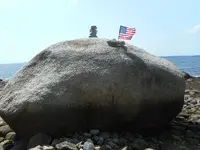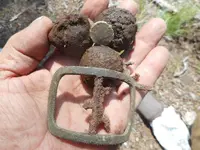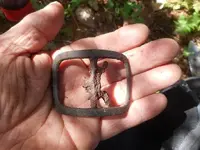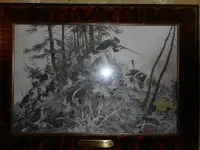Castineman1779
Sr. Member
For u that have been following my hunts at a Rev War site here in Maine in 1779 called "The Penobscot Expedition" thank u for stopping by. For those of u not following my posts to bring u up to speed The Penobscot Expedition was for the most part an unknown battle/ siege in July and August 1779 where the British decided to build a fort, now called Fort George in Castine , Maine. Not long after they arrived in June of 1779 word got down to Boston the British had a foothold in now Castine and an expedition was put together dislodge them. It took about 30 days to raise a fleet of 37 vessels of which 19 were ships of WAr , procure the ordnance needed , form a battle plan and raise a militia of 1500 men from those not in current service . Sailing from Boston harbor the fleet stopped and picked up militia along the way but of the 1500 soldiers needed only 872 were gathered . Many were young boys and old men. Meanwhile the British commander , General McClean with his 600 74th Regt of Foot and 200 82nd REgt of Foot with 3 ships of war and 100 sailors and Marines got word an expedition had been formed in Boston from his spies on the 21st and even knew the name of the commander and his ships names as well Now only a matter of time would do battle with the Americans . He had about 6 weeks to prepare . Gen Lovel, the American commander no knowledge of the enemy .The American's arrived in the Penobscot bay on the Penobscot river on the 25th of July and immediately began a Naval battle with the 3 British Men of WAr. The Brits held the high ground and had placed artillery batteries that thwarted the efforts to destroy the British ships. Day one was a draw. Day two the American's took a small island and captured 3 artillery pieces and ran off the artillery men. Still in order to talk the fort the American's needed to land soldiers to do battle with Gen McLean's men.
On the 28th of July 1779 , exactly 240 years ago as of this writing this morning the American's made good that landing on the western part of the peninsula . 300 militia and 100 Marines shoved off from their boats to a rocky beach where about 70 British 82nd REgt of Foot had been placed on a height of ground 200 feet above the beach their night before by the British commander expecting a possible landing there. Prior to the landing 4 American ships cannonaded British on the Heights for 30 minutes. When the American's landed on the beach in the first wave the Brits opened fire firing musket balls that one American later said were like "hailstones" raining down on us. The American commander gave an order to fire two volleys at the Brits about 200 feet above them , shoulder their muskets and climb that steep precipice . When at the top reengage the enemy. This battle or skirmish lasted about 20 minutes with about 100 of the Americans out of action. Records do not reflect the loss of American's lives in that short period. Estimated , depending on who did the writing of this event ,14 or 15 killed climbing this height of ground and another 6 when engaging Brits on flat ground . British 35 killed or wounded. The landing was a success and the American's got a foothold on the enemies ground. However flushed with success the American commanders decided it was a good days work and instead of continuing on to take the fort now with an additional 500 men from later landing they dug in . Col Paul Revere brought up his cannon and for the next 3 weeks there was sme small skirmishes between the armies and daily cannonading if both armies. The American's did not force the action to take Fort George. Meanwhile Commadore Collier the British British naval commander sailed from New York and came to the aid of Gen McClean on the 11th of August forcing the American's to abandon their efforts to take the fort , return to their ships and were chased by Colliers fleet up the Penobscot River where he whole feet blew up their shipping. Considered to be an overwhelming success turned out to be a humiliating failure with the loss of 500 men .
I have relic hunted Castine and this battle site now for 23 years and hunted the beach where Cpt George Hinkley in the first few minutes was killed on a large boulder on the beach on the landing on the 28th of July 1779, , now called "Trask Rock" and a few years ago found one of his shoe buckles . I have hunted that slope of ground the mem climbed that
early morning where many lost their lives and where the Brits engaged the Americans on the Heights . Found ordnance fired at the Brits from the American ships and the gold guinea found this year lost by a British officer under fire. Even a 1762 Spanish 2 reale an American lost climbing this slope. It indeed has been an exiting 23 years as a student if this battle and fortunate to be the curator of history that has come under my coil. One thing as an old soldier to show my respect is take the now 35 mile trip on Memorial and Veteran's day make that 15 minute walk to were this one day the American's on that rocky shore showed courage under fire and for some not return to the warmed of a loved one. This year I brought two small American flags with me, decended that slope of ground above Trask Rock and planted one on top of it in memory of Cpt George Hinkley probably first to die while spurring on his men. Accended that 200 foot slope of ground ,as they did 240 years ago , and planted close to where American's who died that morning on the Heights are now buried. I render then a hand salute as they are not forgotten .
My first pic is called "Assault at Penobscot 1779" and was painted by Charles Waterhouse. The large painting was hanging in the Pentagon and destroyed in 911. The 2nd Trask Rock and 3rd and 4th self explanatory. So as to make this not just a history lesion and "Today's Find's" the last pics are of history dug that day. It was a good hunt with 3 large grape shot and a British shoe buckle and pewter vest button. Both found within feet of each other and from the same soldier.
On the 28th of July 1779 , exactly 240 years ago as of this writing this morning the American's made good that landing on the western part of the peninsula . 300 militia and 100 Marines shoved off from their boats to a rocky beach where about 70 British 82nd REgt of Foot had been placed on a height of ground 200 feet above the beach their night before by the British commander expecting a possible landing there. Prior to the landing 4 American ships cannonaded British on the Heights for 30 minutes. When the American's landed on the beach in the first wave the Brits opened fire firing musket balls that one American later said were like "hailstones" raining down on us. The American commander gave an order to fire two volleys at the Brits about 200 feet above them , shoulder their muskets and climb that steep precipice . When at the top reengage the enemy. This battle or skirmish lasted about 20 minutes with about 100 of the Americans out of action. Records do not reflect the loss of American's lives in that short period. Estimated , depending on who did the writing of this event ,14 or 15 killed climbing this height of ground and another 6 when engaging Brits on flat ground . British 35 killed or wounded. The landing was a success and the American's got a foothold on the enemies ground. However flushed with success the American commanders decided it was a good days work and instead of continuing on to take the fort now with an additional 500 men from later landing they dug in . Col Paul Revere brought up his cannon and for the next 3 weeks there was sme small skirmishes between the armies and daily cannonading if both armies. The American's did not force the action to take Fort George. Meanwhile Commadore Collier the British British naval commander sailed from New York and came to the aid of Gen McClean on the 11th of August forcing the American's to abandon their efforts to take the fort , return to their ships and were chased by Colliers fleet up the Penobscot River where he whole feet blew up their shipping. Considered to be an overwhelming success turned out to be a humiliating failure with the loss of 500 men .
I have relic hunted Castine and this battle site now for 23 years and hunted the beach where Cpt George Hinkley in the first few minutes was killed on a large boulder on the beach on the landing on the 28th of July 1779, , now called "Trask Rock" and a few years ago found one of his shoe buckles . I have hunted that slope of ground the mem climbed that
early morning where many lost their lives and where the Brits engaged the Americans on the Heights . Found ordnance fired at the Brits from the American ships and the gold guinea found this year lost by a British officer under fire. Even a 1762 Spanish 2 reale an American lost climbing this slope. It indeed has been an exiting 23 years as a student if this battle and fortunate to be the curator of history that has come under my coil. One thing as an old soldier to show my respect is take the now 35 mile trip on Memorial and Veteran's day make that 15 minute walk to were this one day the American's on that rocky shore showed courage under fire and for some not return to the warmed of a loved one. This year I brought two small American flags with me, decended that slope of ground above Trask Rock and planted one on top of it in memory of Cpt George Hinkley probably first to die while spurring on his men. Accended that 200 foot slope of ground ,as they did 240 years ago , and planted close to where American's who died that morning on the Heights are now buried. I render then a hand salute as they are not forgotten .
My first pic is called "Assault at Penobscot 1779" and was painted by Charles Waterhouse. The large painting was hanging in the Pentagon and destroyed in 911. The 2nd Trask Rock and 3rd and 4th self explanatory. So as to make this not just a history lesion and "Today's Find's" the last pics are of history dug that day. It was a good hunt with 3 large grape shot and a British shoe buckle and pewter vest button. Both found within feet of each other and from the same soldier.
Amazon Forum Fav 👍
Attachments
Last edited:
Upvote
9










